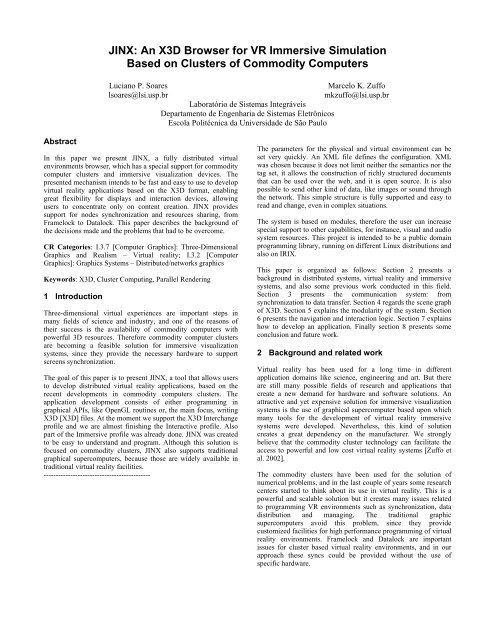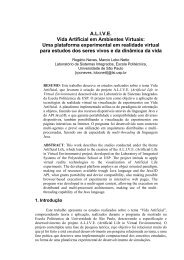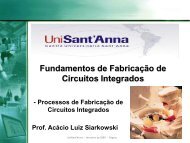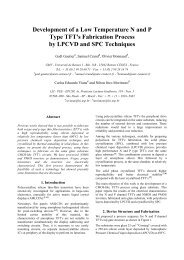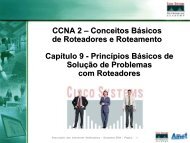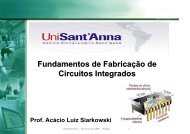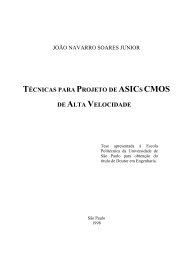JINX: An X3D Browser for VR Immersive Simulation ... - LSI - USP
JINX: An X3D Browser for VR Immersive Simulation ... - LSI - USP
JINX: An X3D Browser for VR Immersive Simulation ... - LSI - USP
You also want an ePaper? Increase the reach of your titles
YUMPU automatically turns print PDFs into web optimized ePapers that Google loves.
<strong>JINX</strong>: <strong>An</strong> <strong>X3D</strong> <strong>Browser</strong> <strong>for</strong> <strong>VR</strong> <strong>Immersive</strong> <strong>Simulation</strong><br />
Based on Clusters of Commodity Computers<br />
Luciano P. Soares<br />
lsoares@lsi.usp.br<br />
Laboratório de Sistemas Integráveis<br />
Departamento de Engenharia de Sistemas Eletrônicos<br />
Escola Politécnica da Universidade de São Paulo<br />
Marcelo K. Zuffo<br />
mkzuffo@lsi.usp.br<br />
Abstract<br />
In this paper we present <strong>JINX</strong>, a fully distributed virtual<br />
environments browser, which has a special support <strong>for</strong> commodity<br />
computer clusters and immersive visualization devices. The<br />
presented mechanism intends to be fast and easy to use to develop<br />
virtual reality applications based on the <strong>X3D</strong> <strong>for</strong>mat, enabling<br />
great flexibility <strong>for</strong> displays and interaction devices, allowing<br />
users to concentrate only on content creation. <strong>JINX</strong> provides<br />
support <strong>for</strong> nodes synchronization and resources sharing, from<br />
Framelock to Datalock. This paper describes the background of<br />
the decisions made and the problems that had to be overcome.<br />
CR Categories: I.3.7 [Computer Graphics]: Three-Dimensional<br />
Graphics and Realism – Virtual reality; I.3.2 [Computer<br />
Graphics]: Graphics Systems – Distributed/networks graphics<br />
Keywords: <strong>X3D</strong>, Cluster Computing, Parallel Rendering<br />
1 Introduction<br />
Three-dimensional virtual experiences are important steps in<br />
many fields of science and industry, and one of the reasons of<br />
their success is the availability of commodity computers with<br />
powerful 3D resources. There<strong>for</strong>e commodity computer clusters<br />
are becoming a feasible solution <strong>for</strong> immersive visualization<br />
systems, since they provide the necessary hardware to support<br />
screens synchronization.<br />
The goal of this paper is to present <strong>JINX</strong>, a tool that allows users<br />
to develop distributed virtual reality applications, based on the<br />
recent developments in commodity computers clusters. The<br />
application development consists of either programming in<br />
graphical APIs, like OpenGL routines or, the main focus, writing<br />
<strong>X3D</strong> [<strong>X3D</strong>] files. At the moment we support the <strong>X3D</strong> Interchange<br />
profile and we are almost finishing the Interactive profile. Also<br />
part of the <strong>Immersive</strong> profile was already done. <strong>JINX</strong> was created<br />
to be easy to understand and program. Although this solution is<br />
focused on commodity clusters, <strong>JINX</strong> also supports traditional<br />
graphical supercomputers, because those are widely available in<br />
traditional virtual reality facilities.<br />
--------------------------------------------<br />
The parameters <strong>for</strong> the physical and virtual environment can be<br />
set very quickly. <strong>An</strong> XML file defines the configuration. XML<br />
was chosen because it does not limit neither the semantics nor the<br />
tag set, it allows the construction of richly structured documents<br />
that can be used over the web, and it is open source. It is also<br />
possible to send other kind of data, like images or sound through<br />
the network. This simple structure is fully supported and easy to<br />
read and change, even in complex situations.<br />
The system is based on modules, there<strong>for</strong>e the user can increase<br />
special support to other capabilities, <strong>for</strong> instance, visual and audio<br />
system resources. This project is intended to be a public domain<br />
programming library, running on different Linux distributions and<br />
also on IRIX.<br />
This paper is organized as follows: Section 2 presents a<br />
background in distributed systems, virtual reality and immersive<br />
systems, and also some previous work conducted in this field.<br />
Section 3 presents the communication system: from<br />
synchronization to data transfer. Section 4 regards the scene graph<br />
of <strong>X3D</strong>. Section 5 explains the modularity of the system. Section<br />
6 presents the navigation and interaction logic. Section 7 explains<br />
how to develop an application. Finally section 8 presents some<br />
conclusion and future work.<br />
2 Background and related work<br />
Virtual reality has been used <strong>for</strong> a long time in different<br />
application domains like science, engineering and art. But there<br />
are still many possible fields of research and applications that<br />
create a new demand <strong>for</strong> hardware and software solutions. <strong>An</strong><br />
attractive and yet expensive solution <strong>for</strong> immersive visualization<br />
systems is the use of graphical supercomputer based upon which<br />
many tools <strong>for</strong> the development of virtual reality immersive<br />
systems were developed. Nevertheless, this kind of solution<br />
creates a great dependency on the manufacturer. We strongly<br />
believe that the commodity cluster technology can facilitate the<br />
access to powerful and low cost virtual reality systems [Zuffo et<br />
al. 2002].<br />
The commodity clusters have been used <strong>for</strong> the solution of<br />
numerical problems, and in the last couple of years some research<br />
centers started to think about its use in virtual reality. This is a<br />
powerful and scalable solution but it creates many issues related<br />
to programming <strong>VR</strong> environments such as synchronization, data<br />
distribution and managing. The traditional graphic<br />
supercomputers avoid this problem, since they provide<br />
customized facilities <strong>for</strong> high per<strong>for</strong>mance programming of virtual<br />
reality environments. Framelock and Datalock are important<br />
issues <strong>for</strong> cluster based virtual reality environments, and in our<br />
approach these syncs could be provided without the use of<br />
specific hardware.
Some solutions <strong>for</strong> distributed virtual reality applications are<br />
available in scientific literature. The Syzygy [Schaeffer and<br />
Goudeseune 2003] is a library that allows the user to create<br />
powerful applications <strong>for</strong> clusters environments. It takes care of<br />
all the issues of synchronization, and has a very robust solution<br />
<strong>for</strong> network connection. But the Syzygy approach creates some<br />
complexity <strong>for</strong> the development of new applications. This is a<br />
problem <strong>for</strong> content developers that are not familiarized with<br />
programming.<br />
synchronized. The Datalock is basically necessary to guarantee<br />
the integrity of the in<strong>for</strong>mation in the nodes along the process and<br />
to avoid coherence problems.<br />
<strong>An</strong>other approach comes from the <strong>VR</strong>Juggler [Bierbaum et al.<br />
2001; Allard et al. 2002]. There are two distributions <strong>for</strong> cluster<br />
environments: NetJuggler [Allard et al. 2002] and Cluster Juggler<br />
[Bierbaum et al. 2003]. The <strong>VR</strong>Juggler is a powerful library that<br />
supports the development of virtual reality environments, but is<br />
not user-friendly. It has support <strong>for</strong> OpenSG [OpenSG], which<br />
creates some flexibility <strong>for</strong> content creation. Avango [Tramberend<br />
1999] and Lightning [Stoll et al. 2001] has also some support <strong>for</strong><br />
cluster, and some research has been done to make it more scalable<br />
[Hinkenjann et al. 2002]. Finally X-Rooms [Isakovic et al. 2002]<br />
is a distributed solution that provides support to online web<br />
content using a modified <strong>VR</strong>ML browser. It has powerful<br />
capabilities like speech recognition and stereo video streaming,<br />
but it is restricted to passive stereo.<br />
<strong>X3D</strong> is a new standard and just recently some browsers have been<br />
released. Xj3D [Xj3D] is the most important one, developed in<br />
Java and Java3D. It is used as a testing ground <strong>for</strong> <strong>X3D</strong>, but it<br />
does not yet support cluster distribution. The <strong>X3D</strong> <strong>for</strong>mat creates<br />
many advantages <strong>for</strong> our implementation. First of all this is a open<br />
standard, then it is easier to have a con<strong>for</strong>mance content, also the<br />
simplicity of this scene graph is very powerful <strong>for</strong> distributed<br />
systems.<br />
Our work is an innovative contribution since it is an integrated<br />
approach to a modular system that allows the user to run the<br />
application in virtually any plat<strong>for</strong>m. This modular system lets the<br />
user change any device specific plat<strong>for</strong>ms commands. For<br />
instance, it is possible to easily change between MPI and Sockets.<br />
Also, with the use of <strong>X3D</strong>, a great freedom of development is<br />
achieved, smoothing the transfer between the modeling tools and<br />
the virtual environment.<br />
3 Communication<br />
3.1 Synchronization<br />
The application presented in this paper allows the user to choose<br />
the communication system between the processes. At this moment<br />
MPI [Pacheco 1997] and TCP/IP sockets network streams are<br />
supported. All the in<strong>for</strong>mation, like the user position, direction<br />
and speed is packed and transmitted by networking every frame,<br />
since this in<strong>for</strong>mation is not too big. In a dedicated fast-Ethernet<br />
connection it is possible to get a maximum frame rate of about 60<br />
f/s and in a gigabit-Ethernet of about 240 f/s. We chose MPI<br />
because it is broadly supported and many network systems<br />
support some sort of MPI distribution.<br />
<strong>An</strong> important feature of the system is the Framelock and<br />
Datalock. In the solution proposed, this is done mainly by a<br />
barrier function. The Framelock blocks the graphical processes<br />
until all of them conclude their own image rendering. When all of<br />
them finish their rendering, a command that is issued at the same<br />
time in all graphical processes, swaps the frame buffer. Figure 1<br />
shows a system with two displays one synchronized and one not<br />
Figure 1 - Image with and without Framelock and Datalock<br />
A suggested intermediate locking is the Timelock, because <strong>X3D</strong> is<br />
animated and based on a specific time, there<strong>for</strong>e all computer<br />
nodes receive a time update at each frame, based on the master<br />
clock, and it is possible to predict the animation of the virtual<br />
objects, based on this time.<br />
Genlock is also an important resource <strong>for</strong> distributed<br />
environments. In complex cluster-based immersive visual<br />
environments, many video signals are necessary to show the<br />
images. The Genlock provides controls to synchronize multiple<br />
screens, Genlock per<strong>for</strong>ms four main functions: vertical,<br />
horizontal, frame, and color synchronization and it is necessary in<br />
active stereo systems, as the active glasses let you see a different<br />
image <strong>for</strong> each eye on each video refresh. <strong>JINX</strong> does not provide<br />
Genlock, but some graphics cards have a connector <strong>for</strong> the<br />
Genlock signal, which makes it very simple to synchronize the<br />
cards. If the graphics card does not support it, another solution is<br />
necessary. One of them is Softgenlock [Allard et al. 2002], which<br />
uses resources of a real time Linux kernel that allows sending<br />
synchronization signals across the parallel port.<br />
3.2 Connection<br />
The application developed can run in many processes, which are<br />
responsible <strong>for</strong> different activities. Figure 2 shows how the<br />
messages are transmitted across the system. This approach allows<br />
the use of heterogeneous clusters or even different architectures<br />
<strong>for</strong> different tasks. For instance the joystick could be connected to<br />
a node and the sound card to another one. This allows the use of<br />
the cluster with great efficiency.
Figure 2 – Network Connection System Sample<br />
The main process is the one responsible <strong>for</strong> the communication<br />
with the other processes, and <strong>for</strong> sending synchronization<br />
messages and merging the data to a common repository, letting<br />
every node know about the state of the system.<br />
There are many processes responsible <strong>for</strong> input treatment. The<br />
input devices supported are: keyboard, mouse, Labtec space<br />
mouse, any kind of joystick, Ascension electromagnetic tracker<br />
and Intersense head tracking devices. All the in<strong>for</strong>mation from<br />
input devices is treated by the input, wand or head tracking<br />
process, filtered, synchronized and sent to the master process, and<br />
finally sent to the output processes, like video and sound<br />
processes. If there are more than one input devices, it is possible<br />
to rate all the device values.<br />
Each input device works in a different way, returning in<strong>for</strong>mation<br />
in different styles. For instance, the tracker sends in<strong>for</strong>mation in a<br />
relative world position. This in<strong>for</strong>mation has to be managed to fit<br />
in the real world. Instead of having the processes reading the<br />
devices directly, they can read the data generated by another<br />
application that gets the hardware in<strong>for</strong>mation, calculates the least<br />
squares <strong>for</strong>mula, converts the data to the real world coordinates<br />
and sends it in an XML stream across the network. In this case the<br />
device could be in any computer, outside the system. These<br />
messages transferred between the processes should be managed so<br />
as not to overflow any other device. The master node should send<br />
some messages of acknowledgment to the input device processes<br />
to control the quantity of messages transmitted. In the case of<br />
using MPI, it buffers the transmitted message, and if it overflows<br />
it loses interactivity.<br />
The output devices supported are video and sound. It is possible to<br />
use video with the correct stereoscopic view, <strong>for</strong> many kinds of<br />
virtual reality environments, like CAVEs [Cruz-Neira et al.1993],<br />
DisplayWall [Chen et al. 2002] or Spherical system [Fernandes et<br />
al. 2003].<br />
<strong>An</strong> important feature is the capability to correct the viewpoint of<br />
the user, based on a head-tracking system. Usually it uses an<br />
electromagnetic tracker <strong>for</strong> this. The rotation and movement of the<br />
eyes should be in<strong>for</strong>med to the computer, allowing it to redisplay<br />
the image in a correct perspective. Figure 3 shows how the<br />
perspective frustum trans<strong>for</strong>ms <strong>for</strong> an example viewpoint. For<br />
stereo the image is similar, but there are two frustums with the<br />
source separated by the eye distance.<br />
Figure 3 – Perspective camera adjustment<br />
The sound spacialization is very important; it radically helps the<br />
feeling of immersion. For the immersion, sound sources points are<br />
defined in the virtual space. Many speakers can be set around the<br />
environment or the user can use some headphones. If the user is<br />
using headphones, it is necessary to use some tracking system to<br />
determine the user position and orientation in the environment.<br />
Otherwise each sound connector in each cluster node could<br />
control one sound speaker. The sound system is based on the<br />
Fmod library [Fmod]. It has the feature to generate 3D sound<br />
spacialization, making the user aware of where the sound is<br />
coming from.<br />
Finally, there is a process responsible <strong>for</strong> interaction, calculating<br />
all the simulation necessary <strong>for</strong> the virtual environment, like<br />
collision detection. It is also possible to use a DIS (IEEE 1278.2)<br />
system to get and transmit in<strong>for</strong>mation about simulation to a<br />
dedicated system. DIS was originally used <strong>for</strong> military<br />
applications and supports a wide range of data using PDU<br />
packages to communicate. We are now looking <strong>for</strong> some DIS<br />
server to use with <strong>JINX</strong>.<br />
3.3 Tasks distribution<br />
The communication across the processes should be as highly<br />
efficient as possible. <strong>JINX</strong> takes advantage of the SMP systems,<br />
that are common nowadays, and high-speed network connections,<br />
defining a transparent protocol <strong>for</strong> communication. Posix threads<br />
and MPI were chosen <strong>for</strong> each respective communication. The<br />
processes are deployed to each node of the cluster based on a shell<br />
script that internally uses the mpirun command to control which<br />
computer will run the application.<br />
SMP systems also use OpenMP <strong>for</strong> internal loops. Un<strong>for</strong>tunately<br />
it is supported mainly in commercial compilers. The specified<br />
communication protocol basically defines the following functions:<br />
Send(), Receive(), Barrier(), Acknowledgment(), and some<br />
variations. Then based in the dispatch script and the configuration<br />
file, showed in Code 1, the program chooses the best way to start<br />
the application in each node, which tasks it is responsible and how<br />
to communicate with other processes. The dispatch script defines<br />
what each node will take care of, like sound, video and input<br />
devices. <strong>An</strong>d the configuration file defines how each node works:<br />
like screen resolution or speaker’s position. Sometimes one node
could have more than one viewport, this is a common case on Irix.<br />
In these architectures it is possible to open many viewports in<br />
different graphic pipelines.<br />
<br />
<br />
<br />
<br />
<br />
<br />
<br />
<br />
<br />
<br />
<br />
<br />
<br />
<br />
<br />
<br />
<br />
<br />
<br />
<br />
<br />
<br />
<br />
<br />
<br />
<br />
<br />
<br />
<br />
<br />
<br />
<br />
<br />
<br />
<br />
<br />
Code 1 – Example of configuration<br />
As showed in Code 1 each computer configuration is centralized<br />
in a common repository. It facilitates the management of the<br />
system, allowing the composition of very complex systems. Aside<br />
from the fact that the insertion of a new node in the cluster is<br />
simple, all executable and configuration code can be read<br />
remotely. The specification used in Code 1 was created to support<br />
the more common virtual reality infrastructures, and it tries to<br />
follow the <strong>for</strong>mat of <strong>X3D</strong>.<br />
Figure 4 – Connection system<br />
Figure 4 shows a complete cluster system. In SMP architectures,<br />
some processors, P1 and P2, can share the same memory. In this<br />
case the communication is very fast. But in some cases it is<br />
necessary to communicate with other processors in different<br />
computers. In this case it is necessary to send data or commands<br />
across the network. The good point about these resources is that<br />
they work together and simultaneously, but special care should be<br />
taken about mutual exclusion, since some parts of the program<br />
may not be thread safe.<br />
4 Scene graph<br />
The library supports both an OpenGL routine and an <strong>X3D</strong> code.<br />
The <strong>X3D</strong> system is based on a scene graph and it should be<br />
controlled in a smart way. Because of the architecture of C++, it is<br />
very simple to simulate each <strong>X3D</strong> node as an object. The <strong>X3D</strong><br />
system has some non-linear links. It means that one node connects<br />
with another one in a different part of the tree. To solve this, a<br />
STL [Breymann 1998] solution was used to create a map that<br />
connects the nodes in any order. It also helps the wand interface,<br />
the collision between the wand bean and the object is calculated<br />
using a ray tracing algorithm that gets the <strong>X3D</strong> nodes position<br />
very fast, making an accurate localization possible.<br />
A XML parser is necessary to parse an <strong>X3D</strong> file. In this project<br />
we use the public parser Xerces[Apache]. The <strong>X3D</strong> structure has<br />
some points that should be carefully managed, like the waste of<br />
memory. Some file lines in an <strong>X3D</strong> object could have billions of<br />
points, represented as floating point numbers. In this case a great<br />
quantity of memory is necessary, and this should be dynamically<br />
allocated and freed.<br />
5 Modularity<br />
The good point about commodity clusters is that the price is low<br />
because there are lots of commodity device parts to build it in the<br />
market. But it creates a large quantity of devices with different<br />
protocols. There<strong>for</strong>e, it is important to think about future releases<br />
and lack of support. In a modular system, new modules could be<br />
added so that the new devices can work. In Figure 5, you can see<br />
some of the modules already developed.
These devices are usually connected by a RS232 or USB<br />
connector, and sometimes these devices are not attached in the<br />
simulation computers. In this case it is possible to connect this<br />
device in a specific computer and send the in<strong>for</strong>mation by a<br />
network stream, using a protocol in XML specified by the library.<br />
7 Development of an application<br />
Figure 5 – Library modularity<br />
The main research <strong>for</strong> network communication is the Glass<br />
library. It is the new version of DiceLib [Gnecco et al. 2001]. It<br />
has many features <strong>for</strong> network communication that are optimized<br />
<strong>for</strong> graphical clusters.<br />
6 Interaction and navigation<br />
There are two control possibilities in a virtual environment: the<br />
navigation system and the interaction system. The navigation<br />
allows the user to walk, fly or execute other movements inside a<br />
virtual world like to move to any viewpoint and to get closer or<br />
farther from somewhere. <strong>An</strong>other possibility is the interaction<br />
with the world. This is accomplished with a wand that lets the<br />
user point at something and changes some parameter, like the<br />
position, or even the color or the shape of an object.<br />
The traditional input devices are the mouse and the keyboard, but<br />
these two are not ideal <strong>for</strong> virtual environments. Usually the<br />
mouse works only in 2D and the keyboard is not easy to carry<br />
around in a virtual environment like a CAVE or Power Wall. But<br />
<strong>for</strong> simulation environments in a single screen it is strongly<br />
recommended, and in this case it should be supported. As many<br />
displays are supported, each one has to support a keyboard and a<br />
mouse, and has to read and send in<strong>for</strong>mation to the master process<br />
so that the other drawing nodes are in<strong>for</strong>med.<br />
The positional electromagnetic trackers are the most popular input<br />
devices <strong>for</strong> immersive environments. There are wired and wireless<br />
models, but the wire usually is not a problem <strong>for</strong> small motion.<br />
The tracker could deliver 6DOF, it is possible to locate the<br />
position and the orientation the user’s head to change his/her<br />
viewpoint or to change the wand position to detect and select a<br />
virtual object. It is just important to remember that the viewpoint<br />
can be changed by any movement in the virtual environment and<br />
also using the tracking system. But these devices do not fit very<br />
well <strong>for</strong> simulation systems in small areas. In this case the use of a<br />
space ball is a better idea. It fits in the same space of a mouse, and<br />
it allows the same 6DOF of the tracker.<br />
One of our first approaches to create 3D content was to use a<br />
conversion tool that generates an OpenGL code from some 3D<br />
<strong>for</strong>mat, but very soon we concluded that it was not a good way to<br />
solve the application data conversion. Then we decided to read<br />
directly the 3D file. As <strong>VR</strong>ML [<strong>VR</strong>ML] is becoming obsolete <strong>for</strong><br />
the technologies available today, a new programming plat<strong>for</strong>m<br />
that is promising is the <strong>X3D</strong> [<strong>X3D</strong>]. It is a powerful system,<br />
plat<strong>for</strong>m independent and open. It is quite possible that many<br />
companies start to use <strong>X3D</strong> <strong>for</strong> a unified 3D <strong>for</strong>mat. There are<br />
some missing structures that could be important in this <strong>for</strong>mat, but<br />
probably they will appear soon. The XML parser is used to read<br />
the <strong>X3D</strong> files. OpenGL is used to render the <strong>X3D</strong> objects, and the<br />
entire scene graph is implemented, following the structure of the<br />
<strong>X3D</strong> model. This <strong>X3D</strong> file usually stays in a web site, and could<br />
be accessed anywhere.<br />
To write an application is quite simple. It is necessary to instance<br />
the Engine class, and define the configuration file. Finally you<br />
specify an <strong>X3D</strong> file or an OpenGL routine.<br />
#include "engine.h"<br />
int main(int argc, char* argv[]) {<br />
}<br />
Engine* engine = new Engine(&argc,argv);<br />
engine->Config("http://foo/render.xml");<br />
engine-><strong>X3D</strong>("http://foo/exemplo.x3d");<br />
//engine->OpenGL(&myDrawGLScene);<br />
engine->run();<br />
delete engine;<br />
return(0);<br />
Code 2 – Example of program<br />
In the Code 2 figure, you can see that the development of a simple<br />
application is very easy. Actually, you can just create an interface<br />
<strong>for</strong> this application and have a program that reads <strong>X3D</strong> files and<br />
displays it in your virtual environment. In the case of using <strong>X3D</strong>,<br />
the program first unpacks the file in a scene graph tree, and starts<br />
to render it in each necessary node.<br />
7.1 Results<br />
Here, there are a few images produced by the system. Some of<br />
them are in a CAVE and others are snapshots of screen images.
Figure 6 – Demo application in the CAVE and Monitor Wall<br />
Figure 6 shows a demo application that uses all the features<br />
already implemented. It is possible to see the tracking system<br />
work <strong>for</strong> the 3D wand. This virtual environment was the first one<br />
created, used to do tests.<br />
Figure 7 – Snapshot of the house model and linear monitor wall<br />
Figure 7 shows a house that was fully modeled using 3D Studio,<br />
converted to <strong>VR</strong>ML and then converted to <strong>X3D</strong>. This is a real<br />
house, and has many special characteristics. The last image shows<br />
a monitor wall presented at an important conference in Brazil, in<br />
this case was used 4 PC computers, each one driving one monitor.
Figure 8 – The Escher model<br />
Figure 8 shows a simulation in the CAVE of an Escher drawing<br />
[Escher et al. 2000]. This is a famous drawing that makes some<br />
illusions using the perspective feeling. In this application we have<br />
6 PC computers and a SGI computer to produce this simulation.<br />
The tracking system, a flock of birds, is attached at the SGI that<br />
sends a XML stream with the coordinates to the PC master<br />
computers. This computer is responsible to manage all other<br />
computers and synthesize the audio. The remaining 5 computers<br />
are each one responsible to render the image <strong>for</strong> each wall.<br />
Figure 9 – Snapshot of hang-gliding over Rio de Janeiro<br />
Figure 9 shows a hang-gliding tour over Rio de Janeiro. It is<br />
possible to see many important places, like Corcovado and Sugar<br />
Loaf. This example has some sounds in Maracanã, the biggest<br />
soccer stadium, and Sambódromo, the carnival parade avenue.<br />
Besides the environment plays the song Girls from Ipanema. This<br />
example was created with Alias Wavefront Maya and converted<br />
to <strong>VR</strong>ML/<strong>X3D</strong>.<br />
8 Conclusions and Future Work<br />
This paper has shown that it is really simple <strong>for</strong> a user to develop<br />
something in <strong>X3D</strong> and use it even in a hybrid and heterogeneous<br />
computer cluster environment. Also there is a possibility to<br />
convert an application in OpenGL, <strong>for</strong> a cluster or a graphical<br />
supercomputer running a virtual reality system. Furthermore it<br />
could be used as a basis <strong>for</strong> many new researches in different<br />
fields, as it is an open system, and advanced functions can easily<br />
be added to the application.<br />
Many features have yet to be implemented, some of the more<br />
important ones are interactive collaborative work, letting a real<br />
camera get the image of the user and redisplay it in the virtual<br />
world as an avatar, and the option to use Iris Per<strong>for</strong>mer or<br />
OpenSG <strong>for</strong> 3D visualization.<br />
All the system is based in XML, but not all possibilities were<br />
explored. In the future work, the software will support some XML<br />
database system to get and send data to a repository, creating a<br />
great flexibility to access data.
<strong>An</strong>other issue is how to integrate the configuration file system,<br />
with the software already developed <strong>for</strong> clusters, like SIRIUS<br />
[Soares et al. 2002], having uni<strong>for</strong>m management resources.<br />
9 Acknowledgements<br />
The authors wish to thank Hilton Fernandes <strong>for</strong> his insights into<br />
C++ programming. Paulo Bressan and Marcio Cabral <strong>for</strong> their<br />
helpful suggestions. The house model was provided by Richard<br />
Ibarra and the Escher model by Leonardo Nomura. We would like<br />
to specially thank Prof. João <strong>An</strong>tonio Zuffo, <strong>for</strong> his constant<br />
support and advising. This work was funded by FINEP<br />
Financiadora de Estudos e Projetos SISCOMPRO project grant<br />
01.02.0288.00 and Intel do Brasil.<br />
References<br />
ALLARD, J., GOURANTON, V., LECOINTRE L., AND RAFFIN B.<br />
2002. Getting Started with NetJuggler and SoftGenLock. <strong>VR</strong> Juggler<br />
tutorial at IEEE Virtual Reality Conference 2002, Orlando, Florida.<br />
APACHE PROJECT, Available at http://xml.apache.org.<br />
BIERBAUM, A., AND CRUZ-NEIRA, C. 2003. ClusterJuggler: A modular<br />
architecture <strong>for</strong> immersive clustering, <strong>VR</strong>-Cluster'03-Workshop on<br />
Commodity Clusters <strong>for</strong> Virtual Reality, IEEE Virtual Reality<br />
Conference 2003, March 22th-26th, Los <strong>An</strong>geles.<br />
SCHAEFFER, B., AND GOUDESEUNE, C. 2003. Syzygy: native PC Cluster<br />
<strong>VR</strong>, Proceedings of IEEE Virtual Reality Conference 2003, 15-22.<br />
SOARES, L., CABRAL, M., BRESSAN, P., FERNANDES, H., LOPES, R., AND<br />
ZUFFO, M. 2002. Managing Commodity Computer Cluster Oriented <strong>for</strong><br />
Virtual Reality Applications, V Symposium of Virtual Reality, Fortaleza<br />
- Ceara, Brazil.<br />
STOLL, G., ELDRIDGE, M., PATTERSON, D., WEBB, A., BERMAN, S., LEVY,<br />
R., CAYWOOD, C., TAVEIRA, M., HUNT, S., AND HANRAHAN, P. 2001.<br />
Lightning-2: a high-per<strong>for</strong>mance display subsystem <strong>for</strong> PC clusters,<br />
Proceedings of the 28th annual conference on Computer graphics and<br />
interactive techniques, 141–148.<br />
TRAMBEREND, H. 1999. Avocado: A distributed virtual reality framework,<br />
Proceedings of IEEE Virtual Reality Conference 99, Texas, , 14-21.<br />
<strong>VR</strong>ML ISO/IEC 14772-1:1997 AND ISO/IEC 14772-2:2002. In<strong>for</strong>mation<br />
technology -- Computer graphics and image processing -- The Virtual<br />
Reality Modeling Language, Available at http://www.web3d.org.<br />
<strong>X3D</strong> ISO/IEC FCD 19775:200X, In<strong>for</strong>mation technology -- Computer<br />
graphics and image processing -- Extensible 3D (<strong>X3D</strong>), Available at<br />
http://www.web3d.org.<br />
XJ3D, Available at http://www.xj3d.org/.<br />
ZUFFO, M., SOARES, L., BRESSAN, P., AND PAIVA, M. 2002. Commodity<br />
Clusters <strong>for</strong> <strong>Immersive</strong> Environments, course on V Symposium of<br />
Virtual Reality, Fortaleza - Ceara, Brazil.<br />
BIERBAUM, A., JUST, C., HARTLING, P., MEINERT, K., BAKER, A., AND<br />
CRUZ-NEIRA, C. 2001. <strong>VR</strong> Juggler: A Virtual Plat<strong>for</strong>m <strong>for</strong> Virtual<br />
Reality Application Development, IEEE Virtual Reality Conference<br />
2001, Yokohama, Japan.<br />
BREYMANN, U. 1998. Designing Components with the C++ STL. Addison<br />
Wesley Longman.<br />
CHEN, H., WALLACE, G., GUPTA, A., LI, K., FUNKHOUSER, T., AND COOK,<br />
P. 2002. Experiences with Scalability of Display Walls, Seventh <strong>An</strong>nual<br />
<strong>Immersive</strong> Projection Technology Symposium.<br />
CRUZ-NEIRA, C., SANDIN, D. J., AND DEFANTI T. A. 1993. Surroundscreen<br />
projection-based virtual reality: The design and Implementation<br />
of the CAVE, ACM SIGGRAPH 93, <strong>An</strong>aheim.<br />
ESCHER, M. C., LOCHER, J. L., AND VELDHUYSEN, W. F. 2000. The Magic<br />
of M. C. Escher, Harry N Abrams.<br />
FERNANDES, K. J., RAJA, V., AND EYRE, J. 2003. Cybersphere: The Fully<br />
<strong>Immersive</strong> Spherical Projection System, Communications of the ACM,<br />
Vol. 46, No. 9.<br />
FMOD music & sound effects system, Available at http://www.fmod.org.<br />
GNECCO, B., BRESSAN, P., LOPES, R., AND ZUFFO M. 2001. DICElib: A<br />
Real Time Synchronization Libray <strong>for</strong> Multi-Projection Virtual Reality<br />
Distributed Environments, Proceedings of 4th SBC Symposium on<br />
Virtual Reality, 338-343.<br />
HINKENJANN, A., BUES, M., ORLY, T., AND SCHUPP, S. 2002. Mixed-<br />
Mode Parallel Real-Time Rendering on Commodity Hardware, In<br />
proceedings of 5th Symposium on Virtual Reality, Fortaleza, Brazil.<br />
ISAKOVIC, K., DUDZIAK, T., AND KÖCHY, K. 2002. X-Rooms: A PCbased<br />
immersive visualization environment, Proceeding of the seventh<br />
international conference on 3D Web technology, 173-177<br />
OPENSG Kickstart Tutorial, Symposium Concepts and Components of<br />
Software Frameworks <strong>for</strong> Interactive 3D Graphics Available at<br />
http://www.opensg.org/.<br />
PACHECO, P. S. 1997. Parallel Programming with MPI. Morgan<br />
Kaufmann Publishers, San Francisco - Cali<strong>for</strong>nia, USA.


